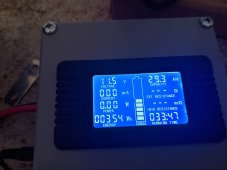SubnetMask
New Member
- Joined
- Dec 6, 2021
- Messages
- 27
I've got my really small experimental setup that has two 100w solar panels wired in series, connected to a Renogy Rover 40w MPPT charge controller, with a 35Ah Duracell deep cycle sealed/AGM battery, and the load on it consists of two PoE IP cameras, a really small switch, a wireless bridge and a passive PoE injector to send power to the cameras. According to the Renogy, at night, with the cameras IR on (highest power draw), the load is about 18.5w/1.5A. Watt Hours is a new concept to me, but I've always 'understood' a batteries Ah capacity to mean that, for example, a 7Ah battery can run a 1A load for 7 hours (assuming full to dead as a doornail). So given that, assuming only 30Ah of the batteries 35Ah is really available for use, then the 1.5A load should be able to run for about 20 hours. Injecting Watt Hours, the battery, again assuming 30 out of 35 Ah as being usable, should be around 360Wh based on 12v. Calculating the load based on Watt Hours comes out to 19.45, which is more or less the same as my Ah 'calculation'. Of course this is a really simple setup with only one battery - when you start putting batteries in series, that's when I really get lost because my understanding was when you put batteries in parallel, you increase capacity while keeping voltage the same, and in series, you increase voltage but don't gain capacity - adding in Watt hours seems to toss that thought on its head because two 35Ah batteries in parallel is 70Ah @ 12v = 840Wh, but the same batteries in series would be 35Ah @ 24v = 840Wh ?.
Now, after that essay, part of this is I'm trying to figure out why my setup isn't running as long as expected... Assuming a full day of good sun where the panels charge the battery up to full fairly quickly (The kind of sunlight I had when I was load testing them with an inverter and they had no issue cranking out over 200w, so whatever the battery needed to come to a full charge, it was going to get), assuming they end up fully on battery around 5pm, based on calculations, they should be able to run fully on battery until like 1pm the next day (19-20 hours), but they consistently shut down before 5am, even if the day before was super clear with lots of sun. So, assuming 12 hours of runtime on battery, and assuming the entire 12 hours is at the highest load, with IR on, the setup is using around 222Wh on battery. It is generally cold out here right now, but even before the temps dropped, it was about the same.
Am I missing something? Do I have it all wrong? Or might there be something not quite right in my setup that is leaving usable capacity on the table?
Now, after that essay, part of this is I'm trying to figure out why my setup isn't running as long as expected... Assuming a full day of good sun where the panels charge the battery up to full fairly quickly (The kind of sunlight I had when I was load testing them with an inverter and they had no issue cranking out over 200w, so whatever the battery needed to come to a full charge, it was going to get), assuming they end up fully on battery around 5pm, based on calculations, they should be able to run fully on battery until like 1pm the next day (19-20 hours), but they consistently shut down before 5am, even if the day before was super clear with lots of sun. So, assuming 12 hours of runtime on battery, and assuming the entire 12 hours is at the highest load, with IR on, the setup is using around 222Wh on battery. It is generally cold out here right now, but even before the temps dropped, it was about the same.
Am I missing something? Do I have it all wrong? Or might there be something not quite right in my setup that is leaving usable capacity on the table?



